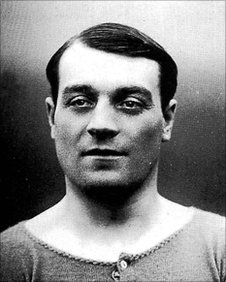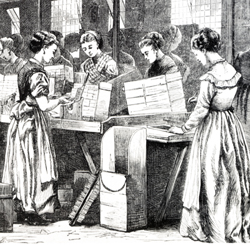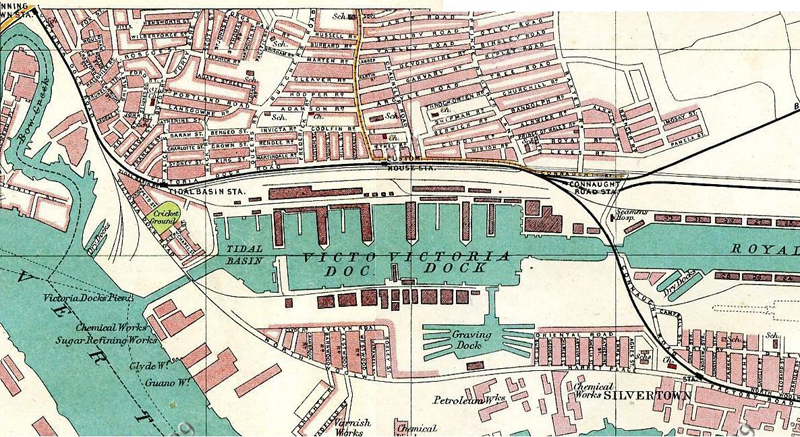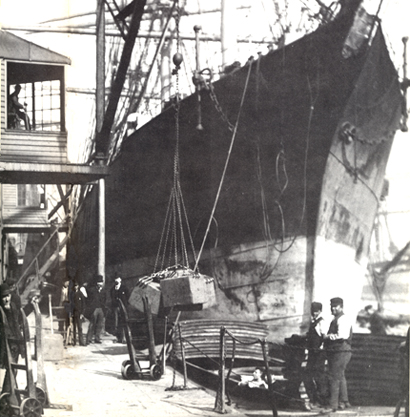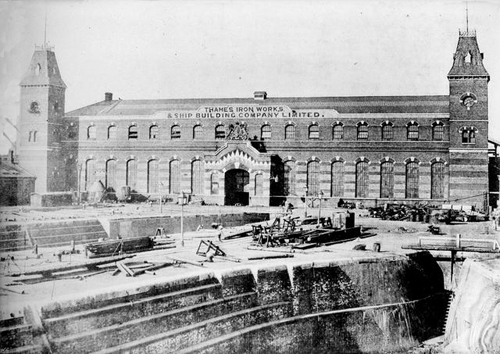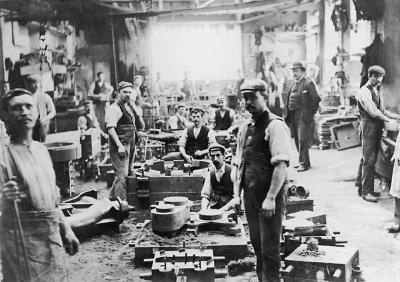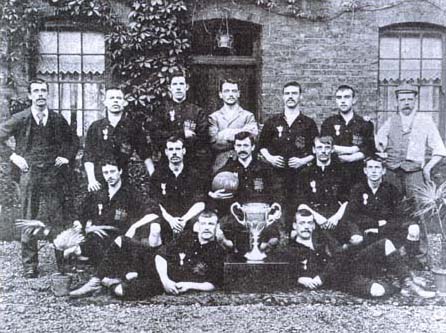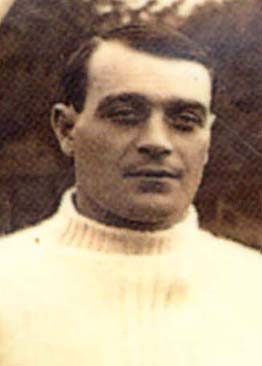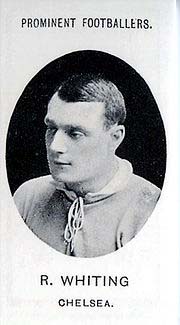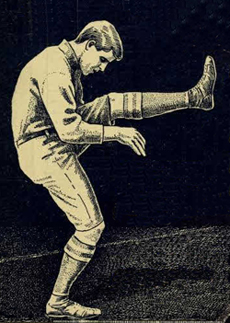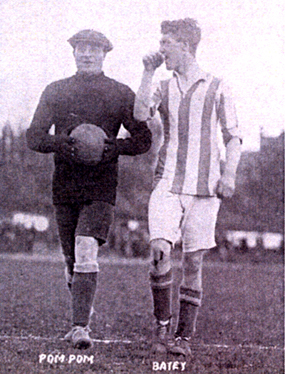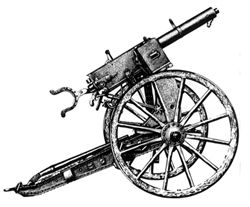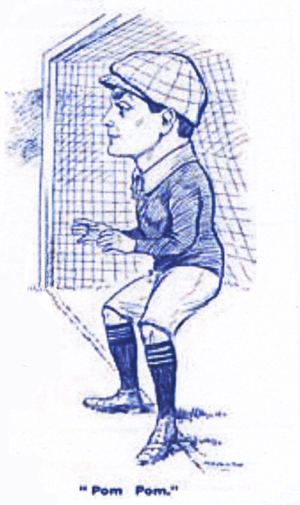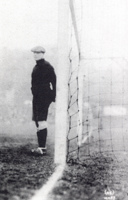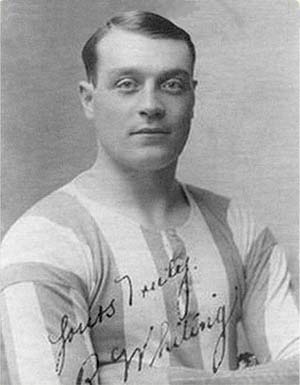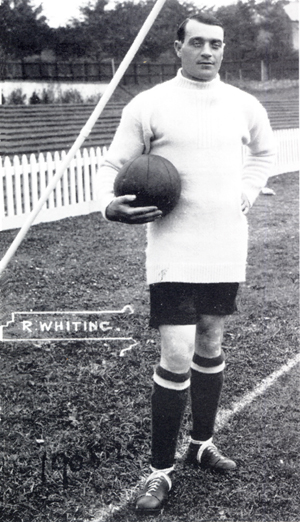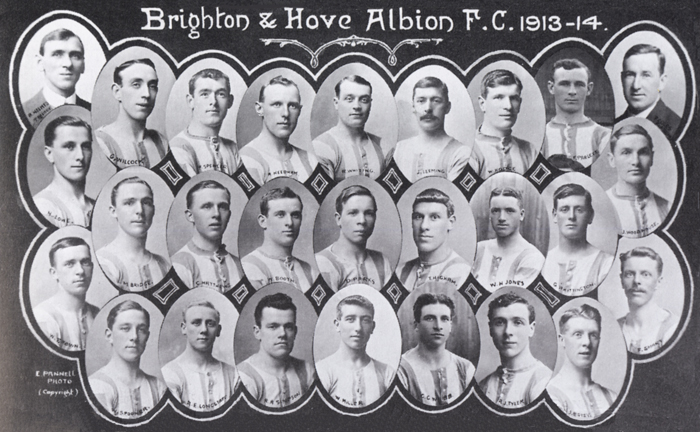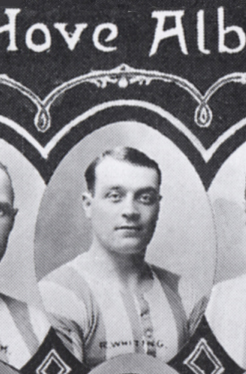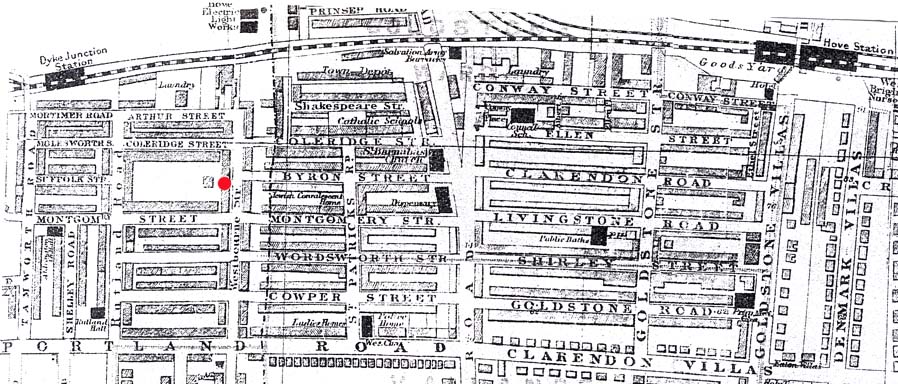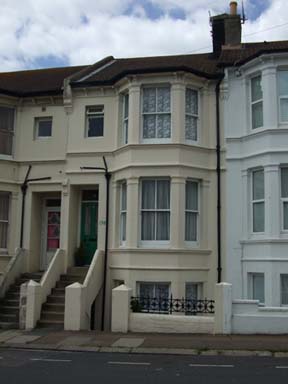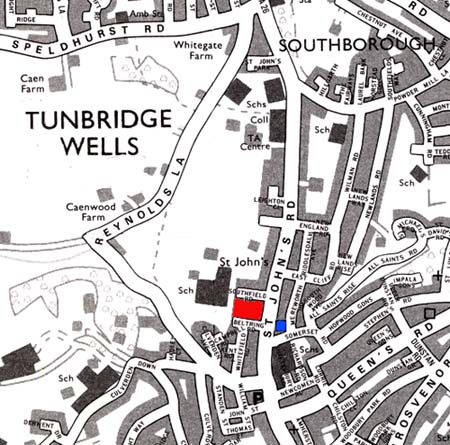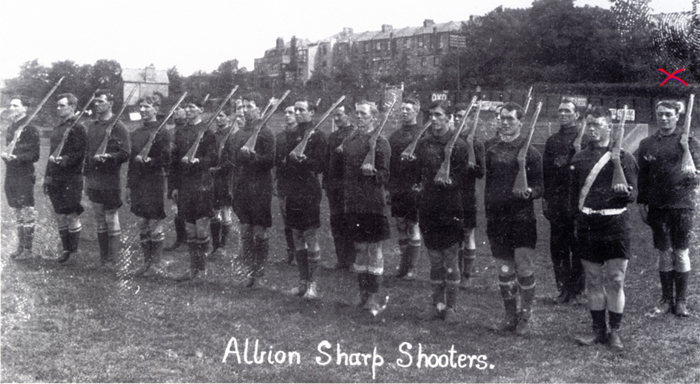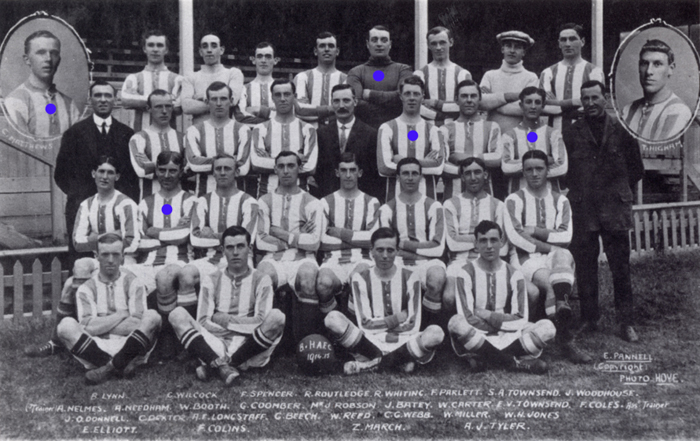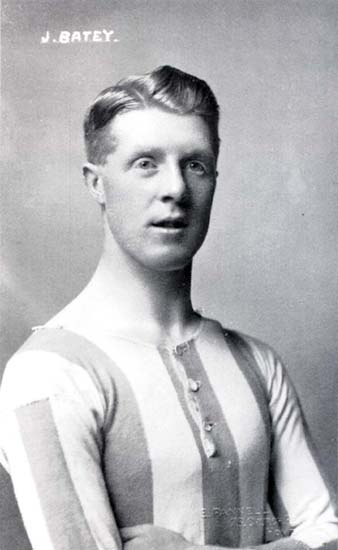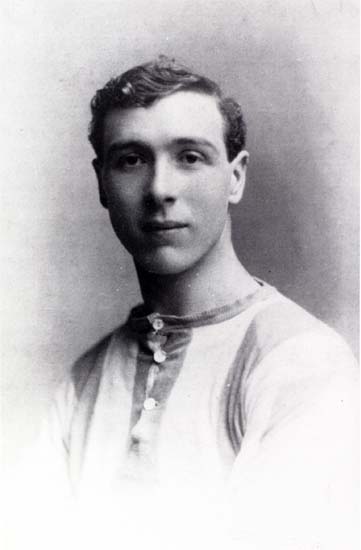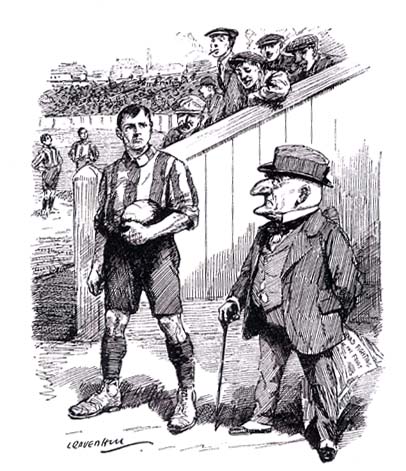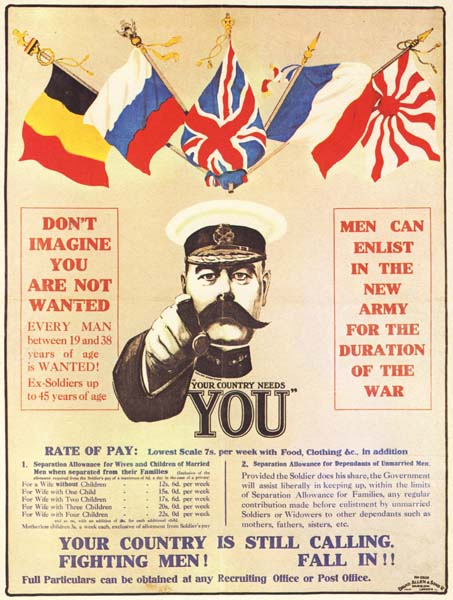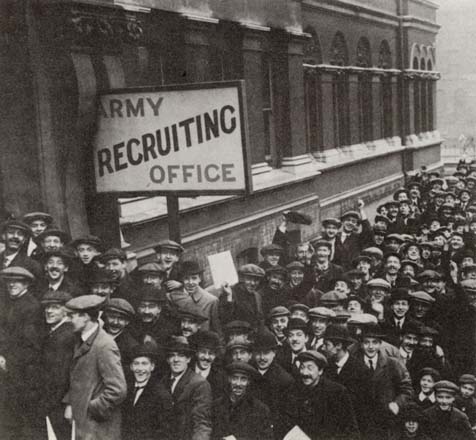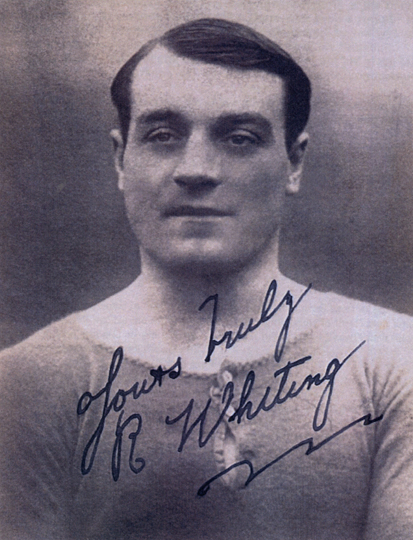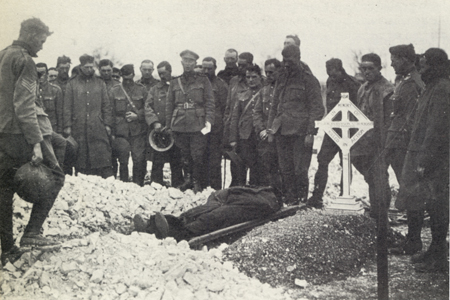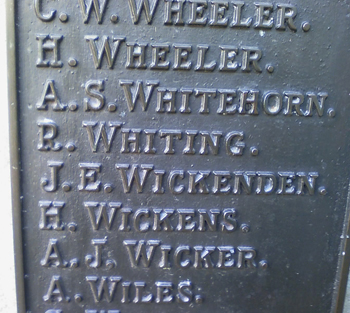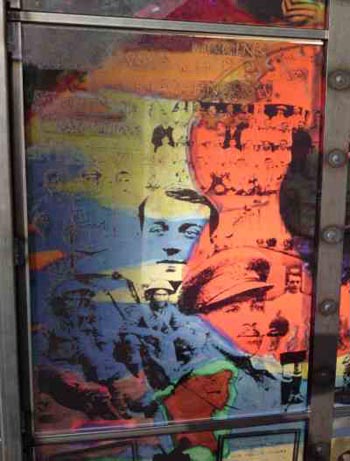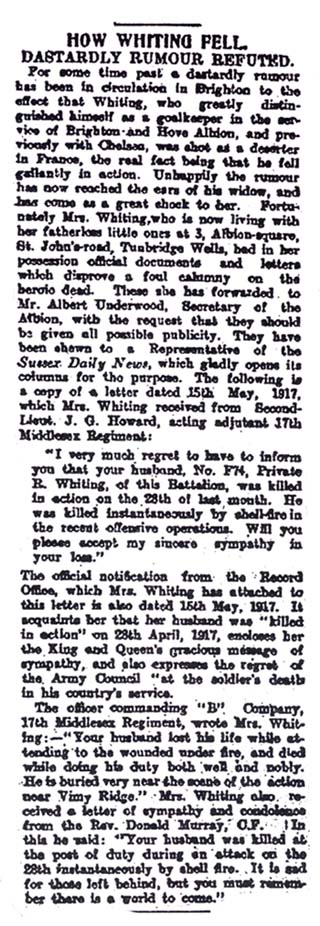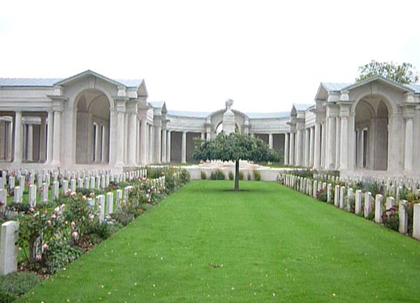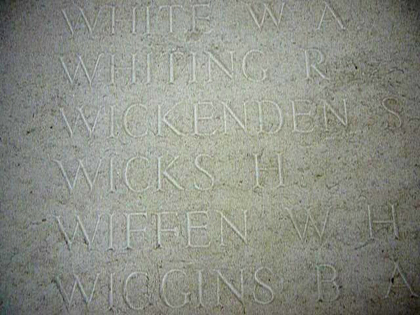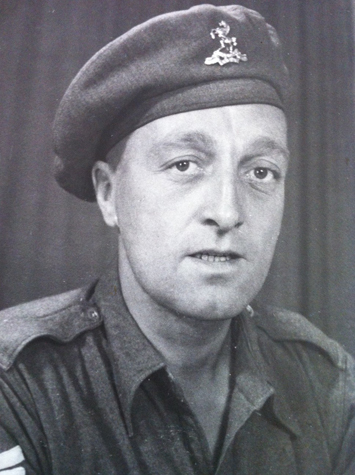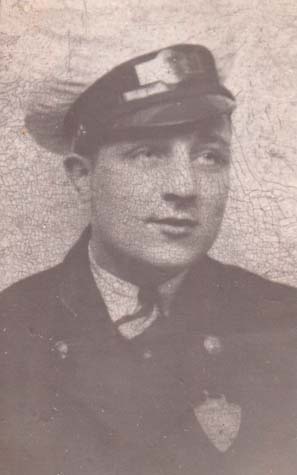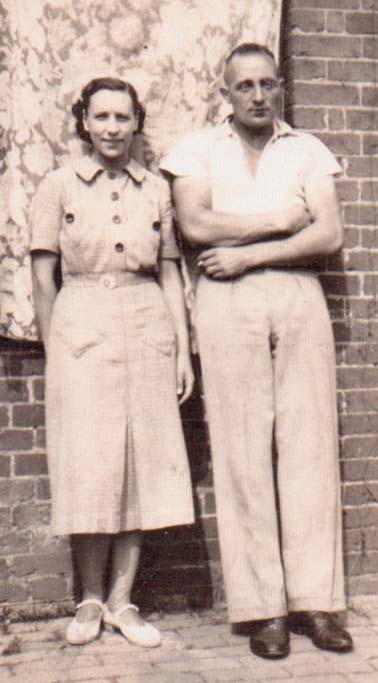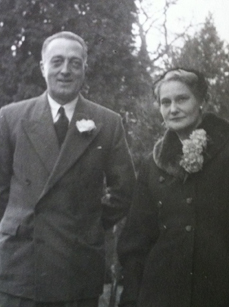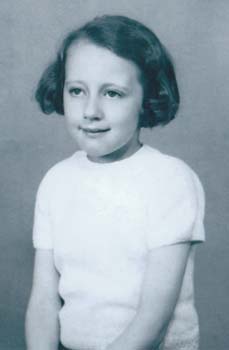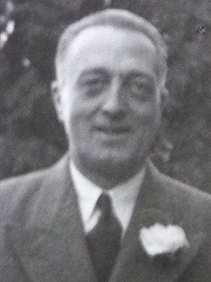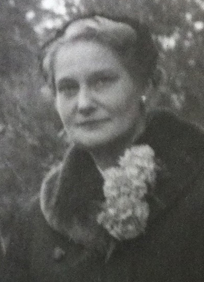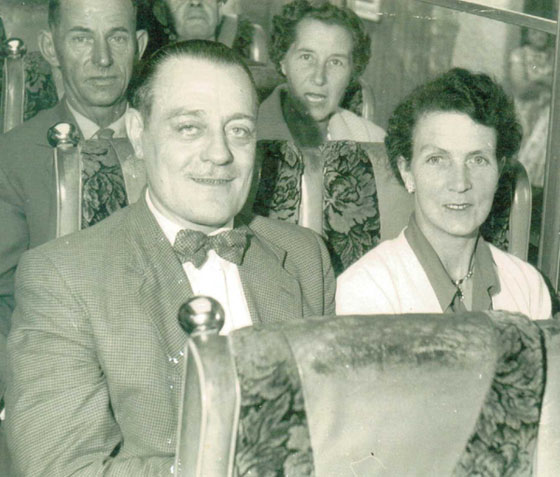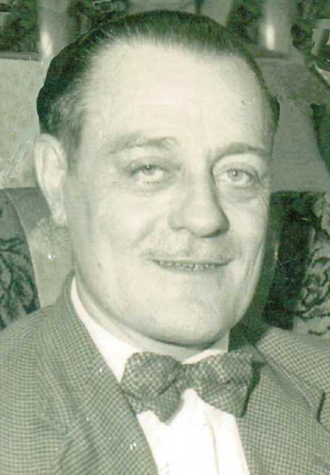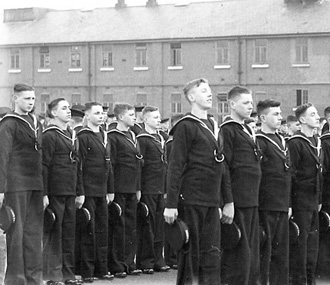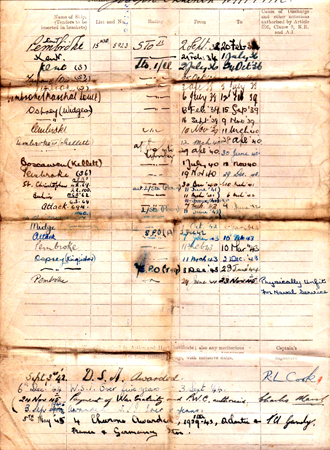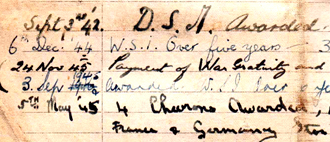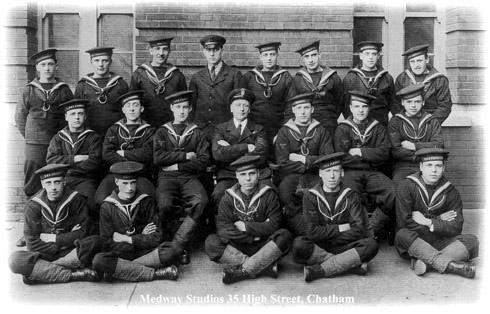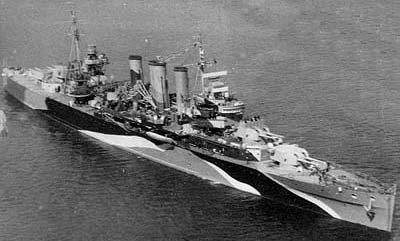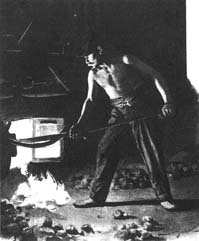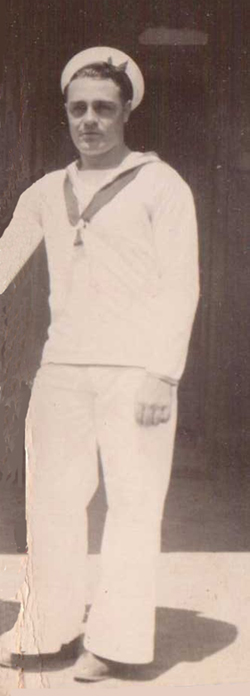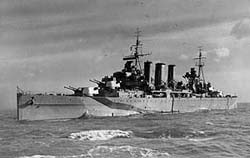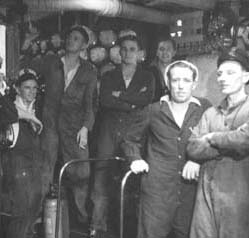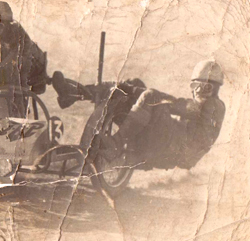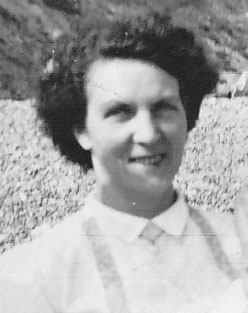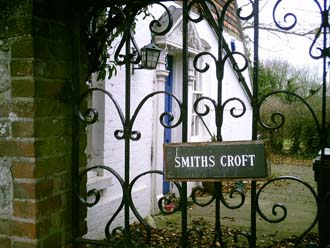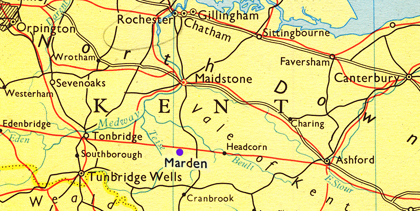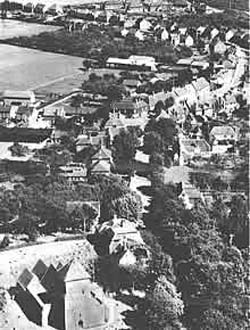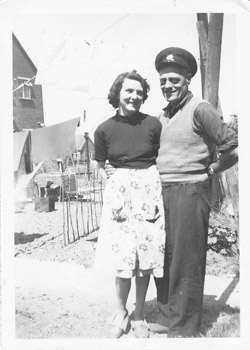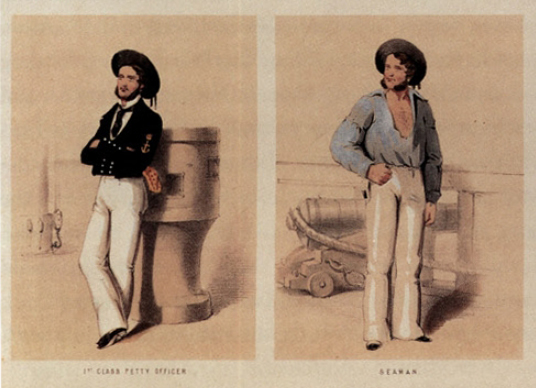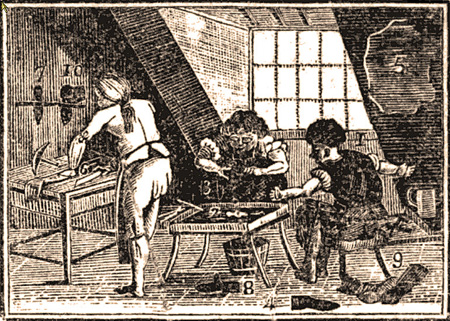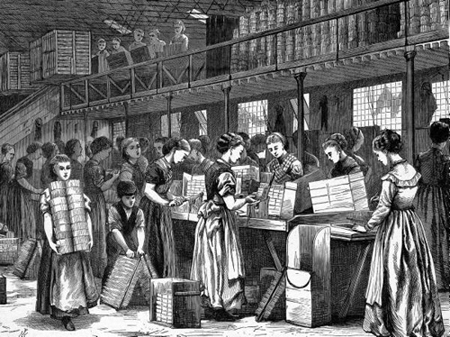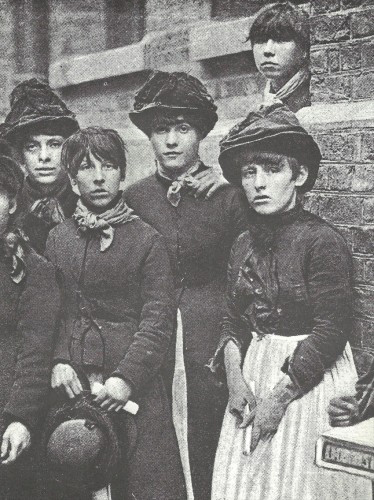| Robert Whiting
enlisted
in the 17th Service Battalion
(Footballers' Battalion) of the
Middlesex Regiment in January 1915. When Robert Whiting signed the Short Service Attestation
Document on 31st January 1915, he gave his home address as 9
Coleridge Street, Hove. In addition to Bob Whiting, more than a
dozen players from Brighton & Hove Albion Football Club were to join
the 17th Service Battalion
(Footballers' Battalion) of the Middlesex Regiment during the
course of the First World War, namely Jasper Matthews Batey,
George Beech, William Booth, Franklin Charles Buckley,
Charles Dexter, John Doran, Frederick Goodwin, William
Henry Jones, William Middleton, Bill Miller, Archibald
Needham, Ralph Routledge, Frank Spencer, Alfred John
Tyler, George Wilcock and John ('Jack')
Woodhouse. Other members of the Brighton & Hove Albion Football Club,
players such as Ernest Victor Townsend of 30 Coleridge Street,
Hove, joined other regiments.
The
17th Service Battalion of
the Middlesex Regiment, also known as the "Footballers'
Battalion" or 1st Football Battalion, had been formed on 12th December
1914 by William Joynson Hicks (1865-1932), a solicitor and
Conservative MP for Brentford. William Joynson Hicks had established the
Battalion specifically to draw professional footballers and football fans
into the British Army. In May 1915, the 2nd Footballers' Battalion,
known as the 23rd Middlesex, was set up.
|
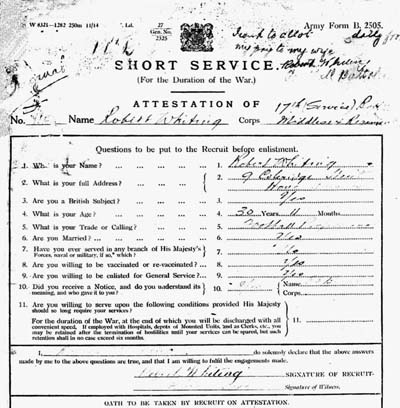 |
|
[ABOVE] The Short Service Attestation
Document signed by Robert Whiting on 31st January 1915 when
he joined the 17th (Service) Battalion,
Middlesex Regiment, also known as the "1st Football
Battalion". |
|
[Document Courtesy of Julia Haydock] |
1915
After basic training at White City, the
17th Service (Football) Battalion
moved on to Cranleigh in April 1915. From Cranleigh, the 17th Service (1st Football) Battalion
were transported to Clipstone Camp, a massive army camp near
Mansfield, Nottinghamshire. After a month at Clipstone Camp, the 17th
Service (1st Football) Battalion travelled south to Perham Down
in Wiltshire. At Perham Down, on the edge of Salisbury Plain, the raw
recruits of the 17th Service (1st Football) Battalion were trained
for armed combat. By June 1915, Bob Whiting, who was now 32 years of age,
had been promoted to the rank of Lance Sergeant. After months of battle training, the 17th Service (1st
Football) Battalion embarked for France, landing at Boulogne
on 18th November 1915.
The 17th Service (1st Football)
Battalion of the Middlesex Regiment were sent to reinforce the troops
based in the trenches near the French town of Loos, the location of a
recent major British offensive. (The Battle of Loos, which took place
between 25th September and 14th October 1915, had resulted in 50,000 British
casualties). By early December 1915, Lance Sergeant Bob Whiting and his comrades in
the 17th Middlesex Regiment were having their first taste of trench warfare.
Bob
Whiting
had enlisted in the
17th Service (Football) Battalion
alongside four of his team mates from Brighton & Hove Albion Football
Club - William Booth, Charlie Dexter, Alfie
Tyler and John ('Jack') Woodhouse. On 7th December
1915, Lance Sergeant Bob
Whiting wrote a letter to
Albert Underwood, the Secretary of Brighton & Hove Albion Football
Club, which indicates the importance of football to Whiting and his
fellow professionals even when on active service on the Western Front:
|
"There
are only five of us (from the Brighton & Hove Albion team) out here
doing our bit - myself, Booth, Tyler, Woodhouse, and Dexter, and they
are very pleased to hear from you, and told me to tell you they are
going on fine. I daresay it has been rotten not having or seeing any
football. There is plenty out here, and we are receiving challenges
every minute of the day. But we are too good for them all. They are
trying to pick a team out of the whole Army out here to play us, so it
will be a big match, though I think we are certain winners.
Well we are having some exciting times in the "big match" out
here. It is great sport to see our airmen scoring against the
"Allemanges" (German troops) - hoping you will excuse the
bit of French. Going great guns in the French language out here, quite
a genius at it. I hope this will find you and all old friends at
Brighton in the best of health as it leaves me at present. Am looking
forward to be playing next season with the old club."
Extract from a letter dated 7th
December 1915 written by Bob Whiting to Albert Underwood,
the Secretary of the Brighton & Hove Albion Football Club.
|
Jack Woodhouse, a former Brighton &
Hove Albion footballer who was serving alongside Bob Whiting in the
17th Service (Football) Battalion
wrote more specifically about their experiences in the trenches:
|
"We have been in the
firing line just over a week. It was an exciting experience the first
day or so to hear our big guns firing behind us and the whistling and
bursting of the German shells overhead, but after the first few days
it seemed a matter of course. We have had some miserable and wet
weather since we have been here, and the trenches are knee deep in
mud, but all the boys seem happy enough."
Extract from a letter
dated 18th December 1915 written by Private Jack Woodhouse to Albert
Underwood, the Secretary of
the Brighton & Hove Albion Football Club. |
1916
Bob
Whiting and the 1st Football Battalion
returned to the Western Front on 15th January 1916. During their first few weeks on
the front line, four members of the 1st Football Battalion were
killed.
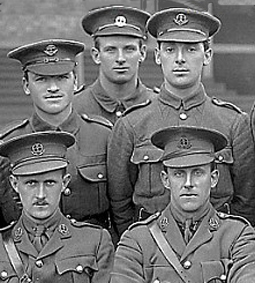 |
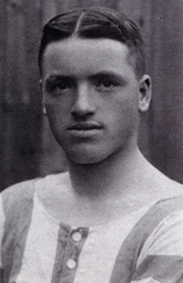 |
|
[ABOVE] Detail from a group photograph of
officers and men of the 17th Middlesex (1st Football Battalion)
Regiment showing, in the back row, three former members of the
Brighton & Hove Albion Football Team. From left to right:
Private William H. Jones
(see photo right),
Private William 'Billy' Booth and Private George Beech. |
[ABOVE] William H. Jones, photographed
in 1910 wearing the Brighton & Hove Albion football
strip. Between 1913 and 1914, Bill Jones played alongside
Bob Whiting in Brighton & Hove Albion's first team.
|
In the spring of 1916, the 1st
Football Battalion moved south to Vimy Ridge, where it
experienced heavy fighting near Souchez and sustained a number of casualties.
It was while serving in the filthy conditions of the front line that
Lance Sergeant Bob Whiting contracted scabies. Towards the end of
May 1916, Lance Sergeant Whiting was evacuated to England and sent to
The
2nd Eastern General Hospital in Dyke Road, Brighton,
for treatment. During his sick leave in
Brighton, Bob Whiting was able to meet up with his wife, Nellie.
Already the mother of two young boys ( Robert Leonard, aged 8, and William
James, aged 6), 'Nellie' Whiting fell pregnant during her husband's
stay in Brighton. As his medical treatment neared completion, Bob
Whiting realised that he would soon be declared fit for active service
and returned to his regiment in France. In June 1916, instead of reporting
for duty, the 'father-to-be' went absent without leave. After 133 days
(nearly 4 months and 2 weeks), Bob Whiting was arrested in October
1916 and charged with "Desertion". The arrest of Bob Whiting was
reported in The Brighton Herald on 21st October 1916:
|
HOVE MAGISTRATES'
COURT |
|
ALBION FOOTBALLER AS
ABSENTEE. |
|
On Saturday Robert Whiting, a
private in the Footballers' Battalion of the Middlesex Regiment,
was remanded to await an escort. He was charged with being an
absentee since June last, but pleaded not guilty on the ground
that he had been suffering from a complaint for which he entered
hospital in May. Defendant told Detective-Sergeant Adlam that he
had been treated in hospital, and that he was not in a fit
condition to travel.
Whiting was before the war the
goalkeeper of the Brighton and Hove Football Club, and a very
well-known figure in the football world. |
The Brighton Herald
(21st October 1916) |
At his Court Martial in December 1916,
Lance Sergeant Bob Whiting was demoted to the rank of Private and
sentenced to 9 months imprisonment with "hard labour".
During the time that Bob Whiting was
away from his Battalion, the 17th Middlesex Regiment had seen action on the
Somme, fighting at Delville Wood and Guillemont. During the
Battle of the Somme in July 1916, the First Football Battalion
suffered heavy casualties. (In a 3-day engagement at Delville Wood
towards the end of July, 36 members of the Football Battalion were
killed). In mid-August, over 700 men had to be drafted in to bring the
Footballers' Battalion up to full fighting strength. In November 1916,
the 1st Football Battalion took part in the attack at Serre
and lost a large number of men, including CSM Joseph Enoch Smith, a former
footballer with Chesterfield Town. In his book The First World War,
the famous historian A. J. P. Taylor noted that on 1st July 1916, the
first day of the Battle of the Somme, "the British sustained
60,000 casualties, 20,000 of them killed - the heaviest loss ever suffered
in a single day by a British Army or by any army in the First World War". 1917
During the 4 months of the Somme Offensive it
has been calculated that the British Commonwealth forces suffered 419,654
casualties (killed, wounded or taken prisoner). At the beginning of 1917,
the British Army was desperately short of fighting men and drastic measures
had to be taken to bring able-bodied soldiers back into the frontline. It
was decided that even those soldiers who had been convicted of serious
offences should be released from prison and sent to France to bolster the
numbers of men needed to mount another offensive against the German Army.
Bob Whiting was among the many soldiers who had their prison sentences
suspended and were released to join the British forces on the Western Front.
In March 1917, Private Bob Whiting was returned to 'B' Company of the
17th Middlesex Regiment, who were then taking up their positions for a major
offensive on the German lines east of the French city of Arras. (See
the map opposite).
Early on the morning of the 28th April 1917, the Football Battalion
of the 17th Middlesex Regiment took part in an attack on German-held
territory around Oppy Wood. The German troops placed around Oppy
Wood were well prepared to meet the British attack. According to a
short history of the Football Battalions (which was published for the Memorial to the Footballers'
Battalions in 2010), "on 28 April 1917, the 17th Middlesex were virtually
annihilated at Oppy Wood during the Arras offensive, only one officer and 41
men returning unscathed from the German lines". Among the hundreds
killed that day was 34 year old Private Robert Whiting.
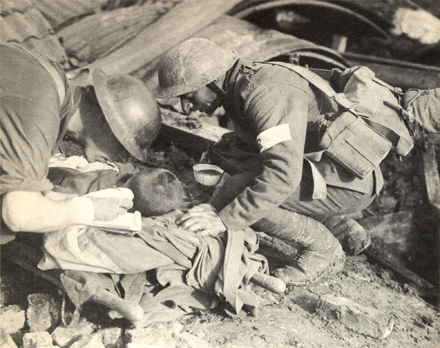
[ABOVE] Soldiers attending a wounded comrade
on the Western Front in 1917. Private Robert Whiting was killed by
shellfire whilst attending wounded soldiers near Vimy Ridge on 28th
April 1917. Private Whiting's commanding officer wrote to Mrs Nellie
Whiting to inform her that her husband "lost his life while
attending to the wounded under fire, and died while doing his duty both well
and nobly".
|
Private Robert Whiting was among 462 men
from the Middlesex Regiment who lost their lives on 28th April
1917 during the Arras Offensive. The casualties from the 17th Middlesex Regiment
that day included: Lieutenant Albert Luvian Wade, a Scottish
Rugby Union player, Private Arthur Eve, Private George
Chambers and Private Charles Edward Green, a former
right-back with Millwall F.C. |
|
|
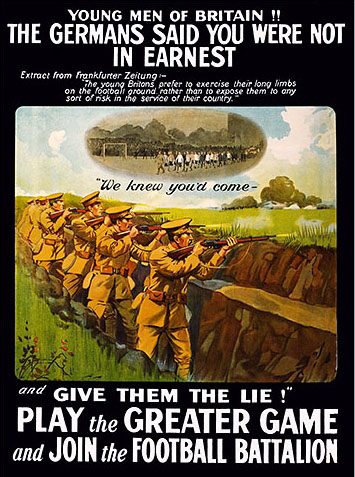 |
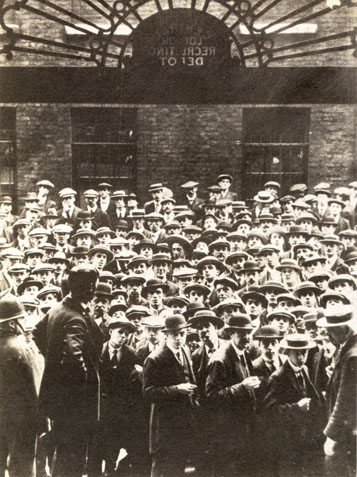 |
|
[ABOVE] Recruitment poster for the
Football Battalion, a division of the 17th Middlesex Regiment.
The poster reproduces a quote from the German newspaper
Frankfurter Zeitung which had made the scornful comment "The
young Britons prefer to exercise their long limbs on the football ground
rather than to expose them to any sort of risk in the service of their
country". The poster urges the "Young Men of Britain" to "give
them the lie" by joining the recently formed "Football Battalion".
Between December 1914 and April 1915, some 300 professional football
players joined the 17th Middlesex Regiment, generally known as
the 1st Football Battalion. Players and officials from London
clubs such as Arsenal, Chelsea, Fulham, Clapton (Leyton) Orient,
Millwall, Tottenham Hotspur and West Ham United enlisted in the Football
Battalion. |
[ABOVE] A large crowd of men gathering
outside the Central London Recruiting Depot in August 1914. Four months
later, on 14th December 1914, at Fulham Town Hall, William Joynson-Hicks, a
Conservative MP, established the 17th Service Battalion of the
Middlesex Regiment, a type of "Pals" battalion which was designed
to attract amateur and professional football players. Although around 500
men attended the Fulham Town Hall meeting, it was reported that only 35
professional footballers enlisted that day. By March 1915, 122 professional
footballers had joined the 17th Middlesex Regiment, which was soon
dubbed the "Football Battalion". The Brighton &
Hove Albion goalkeeper Bob Whiting joined the 1st Football
Battalion on 31st January 1915. Bob Whiting was joined by other
members of Brighton & Hove Albion FC. |
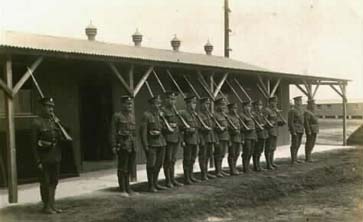 |
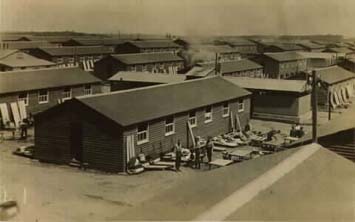 |
|
[ABOVE] New recruits line up outside one
of the wooden buildings at Clipstone
Camp, near Mansfield, Nottingham. The 1st Football Batallion
assembled at Clipstone Camp in 1915. |
[ABOVE] The wooden barracks at Clipstone
Camp, near Mansfield, Nottingham. The 1st Football Batallion
spent a month at Clipstone Camp before travelling down to Wiltshire for
battle training.. |
|
The
17th Service Battalion
(Footballers' Battalion),
Middlesex Regiment |
|
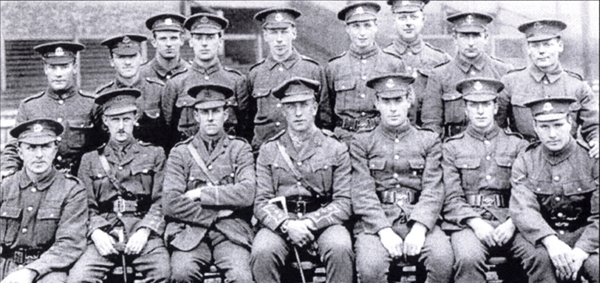 |
|
[ABOVE] A group photograph of officers
and men of the 17th Middlesex (1st Football Battalion) Regiment
(c1917). |
|
[Back row] Sgt Percy Barnfather (Croydon Common),
Pte William Jones (Brighton & Hove Albion), Pte William
Booth (Brighton & Hove Albion), Pte George Beech (Brighton
& Hove Albion), Pte Tommy Lonsdale (Southend United), Sgt
Joe Smith (Chesterfield F. C.), Sgt Yeoval, Pte Frank
Martin (Grimsby Town), Pte Jack Sheldon (Liverpool F.
C.) |
|
[Front row] Pte Pat Gallacher (formerly Tottenham Hotspur),
Capt Edward Bell (formerly of Portsmouth F. C. and Southampton
F. C.), Lt Vivian Woodward (Chelsea F. C.), Capt
Frank Buckley (Bradford City), Pte Sid Wheelhouse (Grimsby
Town), Pte Tommy Barber (Aston Villa), L/Cpl Fred Bullock
(Huddersfield Town). |
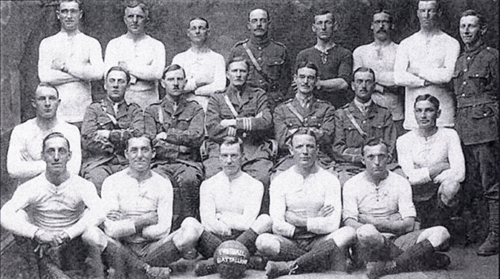 |
|
[ABOVE] Members of the 17th Middlesex (1st
Football Battalion) Regiment Football Team pictured with
officers and NCOs in a team group photograph taken in the Autumn
of 1917. Private John 'Jack' Woodhouse, Bob Whiting's
Brighton & Hove Albion team mate, is kneeling on the extreme right
of the picture in the middle row. [See detail on the right] |
|
[Back row] L/Cpl Jack Doran (Coventry
City), L/Cpl Pat Gallacher (formerly Tottenham Hotspur),
Pte John Spick, RSM Alfred Sabine, Pte Joe Webster
(West Ham United), Sgt Alfred Hollanby, CSM Gibson
(Nottingham Forest), Pte Gardiner. |
|
[Middle row] L/Cpl George Pyke
(Newcastle United), Lt Bennett, Captain Cosmo Clark,
Lt-Col George Kelly, Capt Robert Templeman, Lt
Claude Gann, Pte John Woodhouse (Brighton & Hove
Albion). |
|
[Front row] Pte Jack Dodds (Oldham
Athletic), Pte David Kenney (Grimsby Town), Capt Percy
Barnfather (Croydon Common), Pte John Nuttall (Millwall),
Sgt Charles Stewart (Croydon Common). |
|
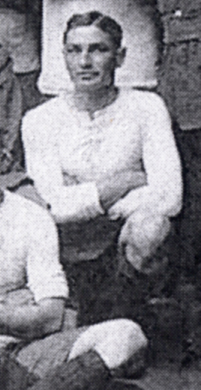 |
|
[ABOVE] Private John 'Jack' Woodhouse,
Bob Whiting's Brighton & Hove Albion team mate. After the First
World War, Jack Woodhouse rejoined Brighton & Hove Albion
FC. |
|
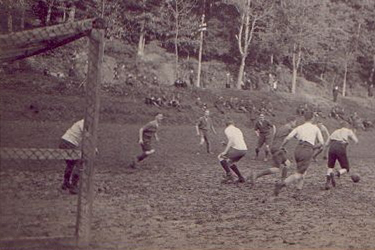 |
|
[ABOVE] British soldiers enjoy a game of
football during the First World War. After arriving on the Western
front in November 1915, the 17th Service (Football
Battalion) were keen to take on other Army football teams. A
Divisional Football Tournament was organized and, unsurprisingly,
the professional footballers of the 1st Football Battalion
defeated every team they faced. The 17th Middlesex (1st
Football Battalion) Regiment Football Team won the Divisional
Football Tournament with ease, achieving victory without conceding
a single goal. Bob Whiting wrote in December 1915: "we are
receiving challenges every minute of the day. But we are too good
for them all". |
|
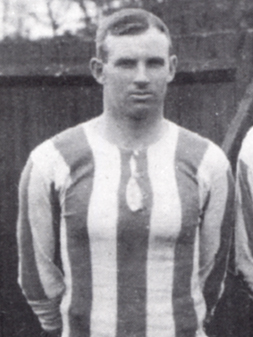 |
|
[ABOVE] William 'Billy' Booth, a
Brighton & Hove Albion half-back who served alongside Bob
Whiting in the 17th Service (Football Battalion)
between 1915 and 1917. |
|
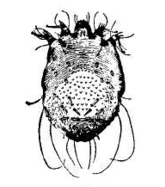 |
|
[ABOVE] A picture of a microscopic scabies mite
greatly magnified
in size. |
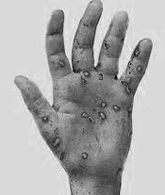 |
|
[ABOVE] An illustration showing the effects
of scabies on a man's hand. |
|
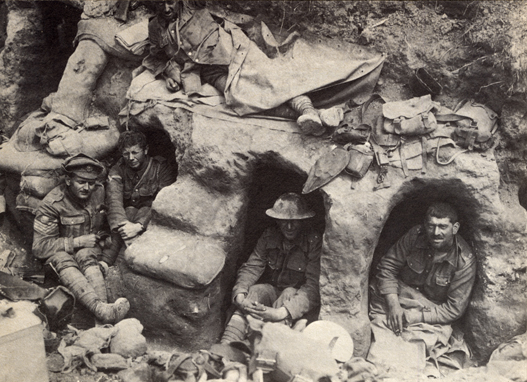
|
[ABOVE] British soldiers photographed in the
unhygienic and overcrowded conditions of a frontline trench on the
Western Front in 1916. These dirty conditions fostered mites, lice
and rats. |
|
[LEFT] Scabies is a contagious skin
infection which is caused by a tiny parasitic mite [see picture
top left] which burrows under the skin of the sufferer. The
disease is usually passed on through direct skin-to-skin contact
but can be transmitted through contaminated clothing, bedding etc.
Infection is generally marked by intense itching and a rash which
follows the superficial burrowing of the mites in the area of the
hands, feet, wrists, elbows, back buttocks and external genitals.
Scabies was the commonest skin disease reported among
British soldiers in the First World War. After Bob Whiting
contracted scabies in 1916 he was sent to England for treatment. |
|
|
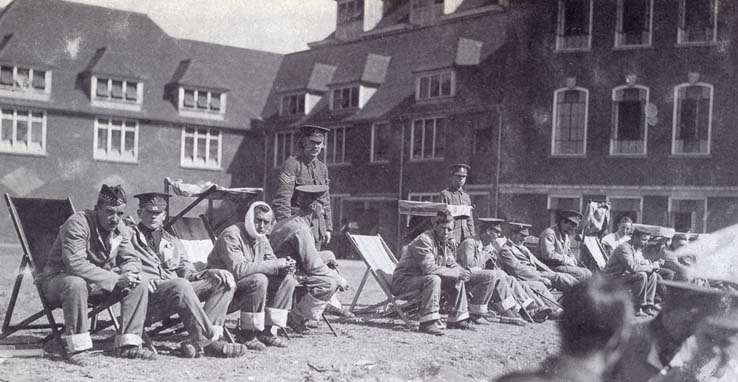
|
|
[ABOVE] British soldiers recuperating at the
2nd Eastern General Hospital in Dyke Road, Brighton.
While serving in the trenches of the Western Front in 1916, Lance Sergeant Bob
Whiting of 17th Battalion, Middlesex Regiment, contracted scabies. Bob
Whiting was sent back to England for treatment. Towards the end of
May 1916, Bob Whiting spent some time at the
2nd Eastern General Hospital in Dyke Road, Brighton,
receiving treatment for his medical complaint, but in June 1916 he went
absent from leave. Whiting was arrested as a deserter in October 1916.
Found guilty of desertion, Lance Sergeant Bob Whiting was demoted to the
rank of Private and sentenced to 9 months "hard labour" in prison. |
| The
2nd Eastern General Hospital in Dyke Road, Brighton was
originally the Brighton, Hove and Sussex Grammar School. The
Grammar School was moved to a new building situated near Dyke Road in
September 1913, but on the outbreak of the First World War it was
requisitioned for use as a military hospital. After the First World War,
the building was once again used as a grammar school. The Brighton,
Hove and Sussex Grammar School closed in 1975 and the building
became the Brighton, Hove and Sussex Sixth form College (BHASVIC). |
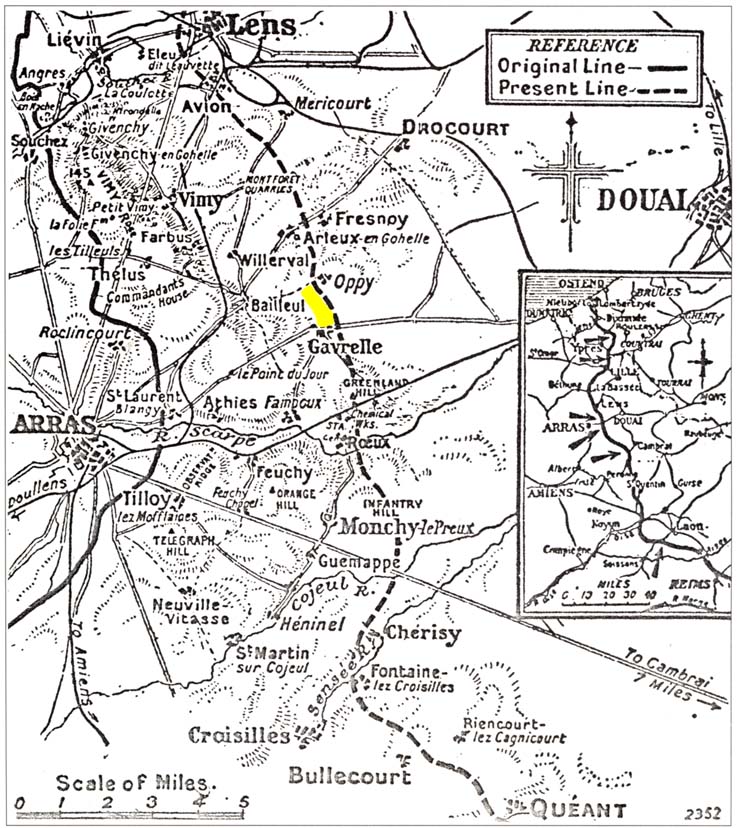
[ABOVE] A map published in a contemporary
newspaper showing the the British advances on the Western Front near
the French city of Arras. As the reference key indicates, the
original front line existing on 9th April 1917 is represented by a solid
black line and the line reached by 5th June 1917 is shown by a line of
dashes running from Lens in the north to Queant in the south.
The military advances represented by this map are known collectively as the
Battle of Arras. The battle began on 4th April 1917 when the British
forces began a massive artillery bombardment of German defences along a 20
mile front. On 9th April 1917, Canadian and British infantry forces launched
an assault on the German positions at Vimy Ridge and the enemy front
line east of Arras. Troops from 17th Service Battalion of the
Middlesex Regiment took part in the military action in the area north
of the River Scarpe. It was during the Arras offensive near
Oppy Wood, in the area of land between Gavrelle and Bailleul,
that Private Bob Whiting of 'B' Company, 17th Service
Battalion (1st Football), Middlesex Regiment was killed in
action on 28th April 1917. |
